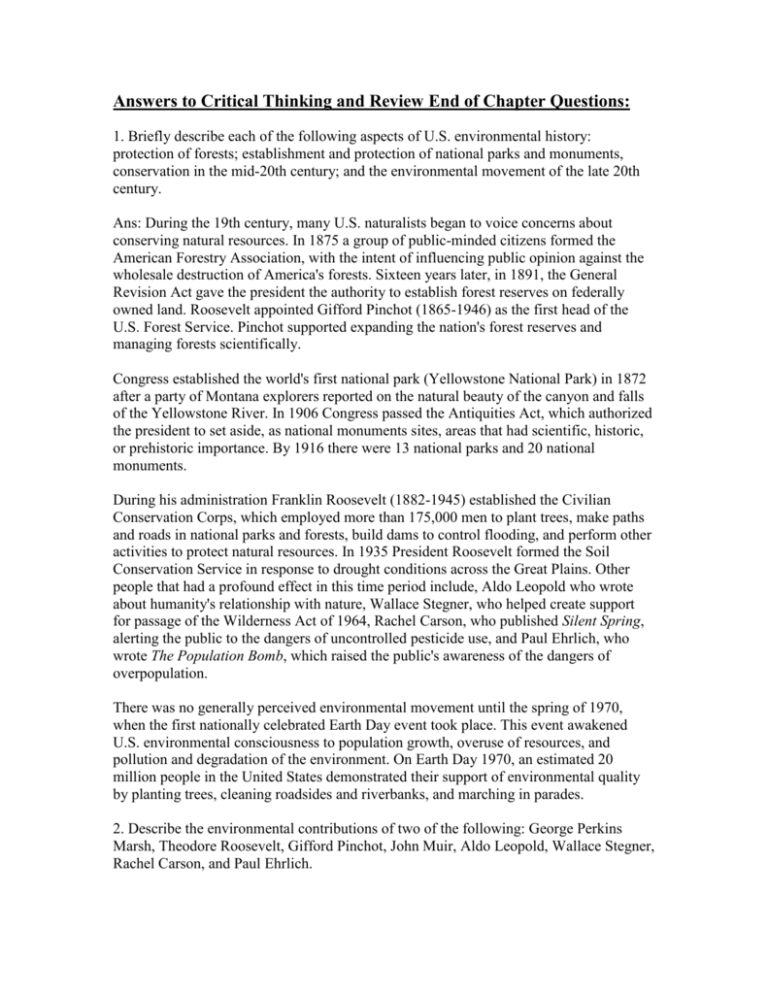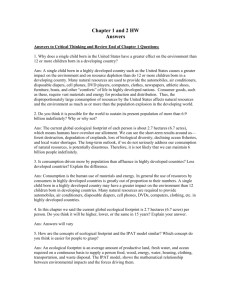Answers to Critical Thinking and Review End of Chapter Questions
advertisement

Answers to Critical Thinking and Review End of Chapter Questions: 1. Briefly describe each of the following aspects of U.S. environmental history: protection of forests; establishment and protection of national parks and monuments, conservation in the mid-20th century; and the environmental movement of the late 20th century. Ans: During the 19th century, many U.S. naturalists began to voice concerns about conserving natural resources. In 1875 a group of public-minded citizens formed the American Forestry Association, with the intent of influencing public opinion against the wholesale destruction of America's forests. Sixteen years later, in 1891, the General Revision Act gave the president the authority to establish forest reserves on federally owned land. Roosevelt appointed Gifford Pinchot (1865-1946) as the first head of the U.S. Forest Service. Pinchot supported expanding the nation's forest reserves and managing forests scientifically. Congress established the world's first national park (Yellowstone National Park) in 1872 after a party of Montana explorers reported on the natural beauty of the canyon and falls of the Yellowstone River. In 1906 Congress passed the Antiquities Act, which authorized the president to set aside, as national monuments sites, areas that had scientific, historic, or prehistoric importance. By 1916 there were 13 national parks and 20 national monuments. During his administration Franklin Roosevelt (1882-1945) established the Civilian Conservation Corps, which employed more than 175,000 men to plant trees, make paths and roads in national parks and forests, build dams to control flooding, and perform other activities to protect natural resources. In 1935 President Roosevelt formed the Soil Conservation Service in response to drought conditions across the Great Plains. Other people that had a profound effect in this time period include, Aldo Leopold who wrote about humanity's relationship with nature, Wallace Stegner, who helped create support for passage of the Wilderness Act of 1964, Rachel Carson, who published Silent Spring, alerting the public to the dangers of uncontrolled pesticide use, and Paul Ehrlich, who wrote The Population Bomb, which raised the public's awareness of the dangers of overpopulation. There was no generally perceived environmental movement until the spring of 1970, when the first nationally celebrated Earth Day event took place. This event awakened U.S. environmental consciousness to population growth, overuse of resources, and pollution and degradation of the environment. On Earth Day 1970, an estimated 20 million people in the United States demonstrated their support of environmental quality by planting trees, cleaning roadsides and riverbanks, and marching in parades. 2. Describe the environmental contributions of two of the following: George Perkins Marsh, Theodore Roosevelt, Gifford Pinchot, John Muir, Aldo Leopold, Wallace Stegner, Rachel Carson, and Paul Ehrlich. Ans: George Perkins Marsh wrote about humans as agents of global environmental change. Theodore Roosevelt removed millions of areas of forest from logging and appointed Gifford Pinchot as the first head of the U.S. Forest Service. Pinchot supported expanding the nation's forest reserves and managing forests scientifically. The Yosemite and Sequoia National Parks were established, largely in response to the efforts of naturalist John Muir. In A Sand County Almanac, Aldo Leopold wrote about humanity's relationship with nature. Wallace Stegner helped create support for passage of the Wilderness Act of 1964. Rachel Carson published Silent Spring, alerting the public to the dangers of uncontrolled pesticide use. Paul Ehrlich wrote The Population Bomb, which raised the public's awareness of the dangers of overpopulation 3. If you were a member of Congress, what legislation would you introduce to deal with each of these problems? a. Toxic materials from a major sanitary landfill are polluting rural drinking water wells. b. Acid rain from a coal-burning power plant in a nearby state is harming the trees in your state. Loggers and foresters are upset. c. Oceanfront property is at risk from sea-level rise caused by global warming. Ans: Answers will vary 4. Following the 2010 oil platform collapse and associated oil spill in the Gulf of Mexico, Congress began considering new laws regulating deep-ocean oil drilling. Do you think command and control or incentive-based regulations would be more effective? Explain Ans: Answers will vary but should include (Historically command and control solutions have been used by the EPA to require the installation of a particular piece of equipment to limit emissions. Incentive-based regulations have taken the approach of using environmental taxes or tradable permits.) 5. Based on what you have learned in this chapter, do you think the economy is part of the environment, or is the environment part of the economy? Explain your answer. Ans: Answers will vary. 6. Explain how environmental taxes can be revenue neutral. Ans: Many countries in Europe have placed taxes on non-renewable resources, such as heating oil, gasoline, and natural gas. At the same time income taxes in these countries were lowered. Increases in taxes on carbon emissions and fuel resources are usually “revenue neutral,” since they are offset by reductions in other taxes or rebates. 8. Can economic approaches to environmental management adequately account for the complex interactive systems that make up the environment? Why or why not? Ans: Answers will vary. 9. The Environmental Performance Index has detractors among both environmentalists and industry groups. Based on what you’ve learned in this chapter, suggest reasons for each. Ans: Answers will vary. 10. Graph the marginal cost of pollution, the marginal cost of pollution abatement, and the optimum amount of pollution. 11. Describe how environmental destruction in formerly communist countries relates to natural capital. Ans: Natural capital is all of Earth’s resources and processes that sustain living organisms, including humans. Natural capital includes minerals, forests, soils, groundwater, clean air, wildlife, and fisheries. Over the previous decades, formerly communist countries have ignored the value of natural capital. Water was so poisoned from raw sewage and chemicals that it could not be used for industrial purposes. Unidentified chemicals leaked out of dumpsites into the surrounding soil and water, while nearby, fruits and vegetables were grown in chemical-laced soil. Power plants emitted soot and sulfur dioxide into the air, producing a persistent chemical haze. Buildings and statues eroded, and entire forests died because of air pollution and acid rain. Crop yields fell despite intensive use of chemical pesticides and fertilizers. One of the most polluted areas in the world was the “Black Triangle,” which consists of the bordering regions of the former East Germany, northern Czech Republic, and southwest Poland. 12. State whether each of the following statements reflects the Western worldview, the deep ecology worldview, or both: a. Species exist for humans to use. b. All organisms, humans included, are interconnected and interdependent. c. There is a unity between humans and nature. d. Humans are a superior species capable of dominating other organisms. e. Humans should protect the environment. f. Nature should be used, not preserved. g. Economic growth will help Earth manage an expanding human population. h. Humans have the right to modify the environment to benefit society. i. All forms of life are intrinsically valuable and have the right to exist. Ans: Western worldviews include a, d, f, g, h Deep ecology worldviews include b, c, e, i 13. What is this cartoon trying to say? When do you think this cartoon was published? Ans: Answers will vary. 14. Do you agree or disagree with the idea that climate change is an environmental justice issue? Explain your position. Ans: Answers will vary.









